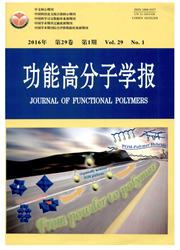

 中文摘要:
中文摘要:
以偶氮二异丁基咪盐酸盐(AIBA)为引发剂,以苯乙烯(St)、丙烯酸丁酯(BA)、季铵盐型阳离子单体2-甲基丙烯酰氧乙基三甲基氯化铵(DMC)及对-乙烯基苄基三甲基氯化铵(VBT)为单体,采用无皂乳液聚合法于80 ℃恒温水浴、300 r/min搅拌条件下,制备了三元共聚物阳离子纳米球P(St-BA-DMC)和P(St-BA-VBT)。通过透射电子显微镜(TEM)、激光粒度分析仪、差示扫描量热仪(DSC)等测试分析,讨论了季铵盐阳离子单体对纳米球结构和性质的影响。结果表明:纳米球P(St-BA-DMC)的粒径随DMC用量的增加先减小后增大,纳米球P(St-BA-VBT)的粒径随VBT用量的增多逐渐减小;阳离子纳米球的表面电荷密度、玻璃化转变温度随阳离子单体的增加而增加;两种阳离子单体分别参与的体系中都存在两种深浅不同的纳米球,原因可能是成核过程中形成的低聚物自由基的疏水性越大,体系中含PS链段较多的密度较大的纳米球所占比例就越大,而低聚物自由基疏水性越小,则体系中含PBA链段较多的密度较小的纳米球就越多。
 英文摘要:
英文摘要:
With 2,2′-azobis[2-methylpropionamidine] dihydrochloride (AIBA) as the initiator, styrene(St), butyl acrylate (BA), quaternary ammonium cationic comonomers methacryloxyethyl trimethyl ammonium chloride (DMC) and trimethyl(vinylbenzyl) ammonium chloride (VBT) as the monomers, the emulsifier-free emulsion polymerization was carried out under thermostatic water bath 80 ℃ and 300 r/min stirring, and the ternary copolymer nanospheres of P(St-BA-DMC) and P(St-BA-VBT) were finally prepared. The effect of quaternary ammonium cationic monomers(DMC/VBT) on the structure and property of nanospheres was analyzed by transmission electron microscope (TEM), laser particle size analyzer, differential scanning calorimetry (DSC) test. Results indicated that the particle size of P(St-BA-DMC) first decreases then increases with increasing DMC amount, while the particle size of P(St-BA-VBT) decreases gradually with increasing VBT amount; Surface charge density and glass transition temperature increases with increasing amount of cationic monomer, respectively. What’s more, in the both different systems, there were two kinds of nanospheres with light and dark shadows seen from TEM. The reason may be that the more hydrophobic oligomer radicals formed in the nucleation process, the more nanospheres containing more PS-oligmers with higher density dominated in the system, otherwise, the less hydrophobic oligomer radicals, the more nanospheres containing more PBA oligmers with lower density were in majority in the system.
 同期刊论文项目
同期刊论文项目
 同项目期刊论文
同项目期刊论文
 Cationic Styrene-Butyl Acrylate-Quaternary Ammonium Copolymer Nanospheres for Surface Modification o
Cationic Styrene-Butyl Acrylate-Quaternary Ammonium Copolymer Nanospheres for Surface Modification o Adsorption of cationic copolymer nanoparticles onto bamboo fiber surfaces measured by conductometric
Adsorption of cationic copolymer nanoparticles onto bamboo fiber surfaces measured by conductometric Adsorption of cationic copolymer nanospheres onto cotton fibers investigated by a facile nephelometr
Adsorption of cationic copolymer nanospheres onto cotton fibers investigated by a facile nephelometr Adsorption of P(St-co-DMHB-co-BA)(n+)center dot Br-n(-) Nanoscale Particles onto Cotton Fiber Surfac
Adsorption of P(St-co-DMHB-co-BA)(n+)center dot Br-n(-) Nanoscale Particles onto Cotton Fiber Surfac Effect of molecular structures of Gemini and polymerizable emulsifiers on cationic emulsion copolyme
Effect of molecular structures of Gemini and polymerizable emulsifiers on cationic emulsion copolyme 期刊信息
期刊信息
